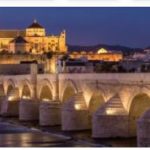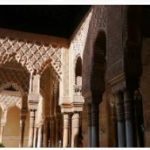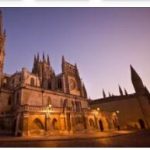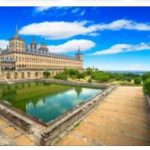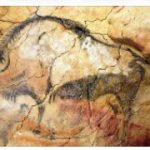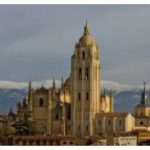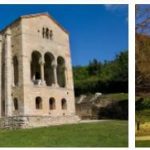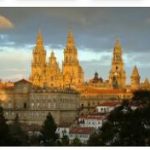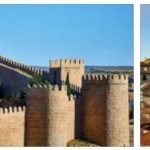Gaudi’s work has significantly shaped the cityscape of Barcelona, for example with the Park Güell, the Palau Güell or the Casa Milà. The Sagrada Família church is one of his most outstanding works and has long been a symbol of the city. The amalgamation of Arabic and Christian, especially Gothic style features becomes clear.
Works by Antonio Gaudí: facts
| Official title: | Works by Antonio Gaudí |
| Cultural monument: | On behalf of the industrialist Baron Eusebi Güell i Bacigalupi, designs by Antonio Gaudí for the park Güell, 0.2 km² in size and enclosed by a wall, in the north-west of Barcelona, and for the Palais Güell with a floor plan of 18×22 m as well as a design for the Casa Milà in Catalan Art Nouveau on behalf of Pere Milà i Camps |
| Continent: | Europe |
| Country: | Spain, Catalonia |
| Location: | Barcelona |
| Appointment: | 1984, 2005 expanded to include the crypt and nativity facade of the Sagrada Familia, the Casa Vicens and Casa Batlló. |
| Meaning: | Honoring the life’s work of Antonio Gaudí |
Works by Antonio Gaudí: History
| 06/25/1852 | Birth of Antonio Gaudí as the son of a coppersmith in Reus |
| 1878 | Order from the city of Barcelona to Gaudí to design a street lamp |
| 3.11.1883 | Beginning of the design work for the Sagrada Familia church |
| 1884-87 | Remodeling of the estate of the industrialist Eusebi Güell i Bacigalupi |
| 1886-89 | Work for Palais Güell, for which 25 plans were drawn |
| 1900-14 | Designs and works for Park Güell |
| 1906-10 | Designs and works for Casa Milà |
| 06/12/1926 | Funeral procession in honor of Gaudí to the Sagrada Familia church, burial in the local crypt |
The architecture or the life
Both the Palais Güell and the Casa Milà break into an urban landscape into which they do not really fit. Because the Palais Güell, built for the friend and patron of the architect Gaudí, Baron Eusebi Güell i Bacigalupi, is located in the thicket of the old town of Barcelona – right next to the Ramblas, in a branch of what later became known as the “Chinese Quarter”, though Until recently there was never a single Chinese living there. Casa Milà, on the other hand, also known as the »quarry« – it makes the amazed viewer think of the terraces of a rock face – breaks through, almost provocative, the carefully maintained harmony of the bourgeois quarter originally built outside the city. The Palais Güell, Another successful design of the tragically killed and at the foot of his “life’s work”, the still unfinished church Sagrada Familia, buried by Catalan architects, shows style elements, especially in the wrought iron ornaments, which anticipated Art nouveau, which played with floral elements. In this representative building, there is a lasting break with traditional forms in order to exaggerate the spatial impression. The use of almost forced structures is to be seen as a sign of the expressive vehemence of Gaudí’s subsequent designs.
According to cheeroutdoor, Casa Milà broke the restraint and decency of the bourgeois clientele of the time and caused scandals and polemics. Contemporary criticism placed this house at the origin of modern architecture and as the beginning of the expressionist style. This finds its expression not only in the facade, which tries to imaginarily replace the architecture with nature, or in the chimneys on the roof terrace, which are constructed like the fruits of a baroque dream, but also in the austere interiors in which the The rhythm of life has to adapt to the dismantling of the conventional relationship between space, volume and function. “The entire facade,” writes the Spanish architect Oriol Guardiola Bohigas, one of the fathers of the master plan for the urban complex for the 1992 Barcelona Olympics.
Gaudí allowed himself all the liberties in order to achieve a maximum artistic way of working that is subject to the view of a social addressee, who in turn is forced to acquire a new perspective both externally and internally.
The increasing explosion of conceptual freedoms reached its climax in Park Güell, which was intended as a settlement of family houses in the countryside. The failure of the financing favored the existence of one of the most beautiful and bizarre parks in the world. The combination of elevated paths, cave paths formed by inclined support pillars and walls and winding passages – as soft as Dalí’s clocks – the portico with Doric columns and its scaled ceiling with ceramic medallions, which were created in collaboration with the architect Josep María Jujol: They are all forerunners of a surrealistic dream that became “real” in the mosaic and broken glass collages on the long bench on the large park terrace. This public seating is like a colorful dragon, which meanders through the landscape and is one of the masterpieces in the history of design. It was also the Güell family who commissioned Gaudí to design a workers’ settlement in Santa Coloma de Cervellò. There Gaudí tried, with a much smaller budget, to create similar challenges between space and volume as in Park Güell. In this design, too, Gaudí remained true to his credo that architecture must change the lives of its users – and not the other way around.

